GMC SIERRA 1998 Owners Manual
Manufacturer: GMC, Model Year: 1998, Model line: SIERRA, Model: GMC SIERRA 1998Pages: 452, PDF Size: 23.65 MB
Page 251 of 452
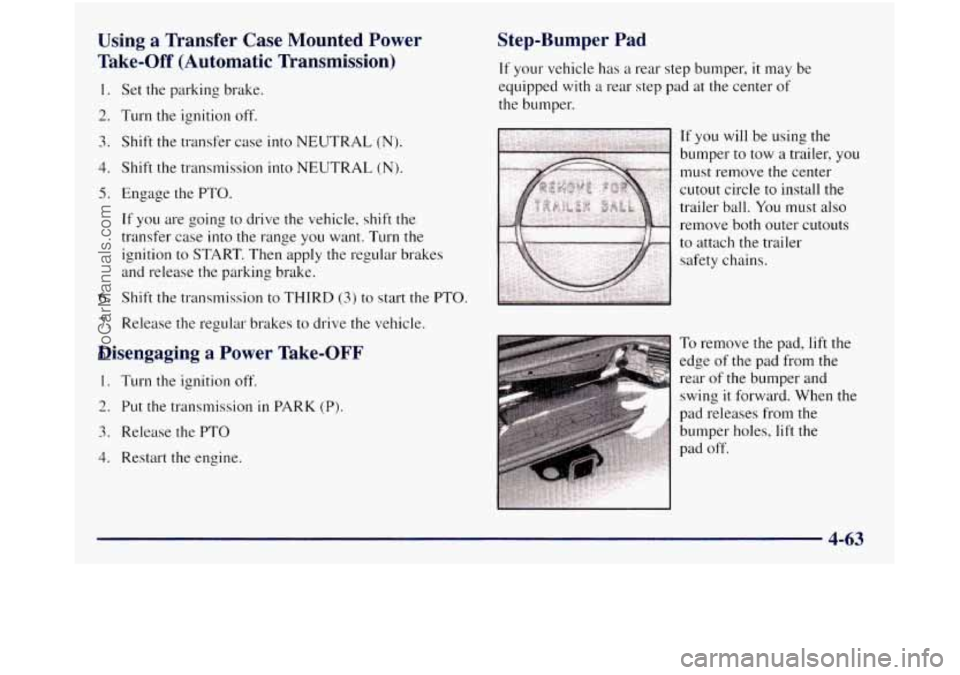
Using a Transfer Case Mounted Power
Take-Off (Automatic Transmission)
1.
2.
3.
4.
5.
6.
7.
Set the parking brake.
Turn the ignition off.
Shift the transfer case into NEUTRAL
(N).
Shift the transmission into NEUTRAL (N).
Engage the PTO.
If you are going to drive the vehicle. shift the
transfer case into the range you want. Turn
the
ignition to START. Then apply the regular brakes
and release the. parking brake.
Shift the transmission to THIRD
(3) to start the PTO.
Release the regular brakes to drive the vehicle.
Disengaging a Power Take-OFF
1. Turn the ignition off.
2. Put the transmission in PARK (P).
3. Release the PTO
4. Restart the engine.
Step-Bumper Pad
If your vehicle has a rear step bumper, it may be
equipped with
a rear step pad at the center of
the bumper.
If you will be using the
bumper to tow a trailer,
you
must remove the center
cutout circle to install the
trailer ball.
You must also
remove both outer cutouts
to attach the trailer safety chains.
To remove the pad,
lift the
edge of the pad from the
rear of the bumper and
swing it forward. When the
pad releases from the
bumper holes,
lift the
pad off.
4-63
ProCarManuals.com
Page 252 of 452
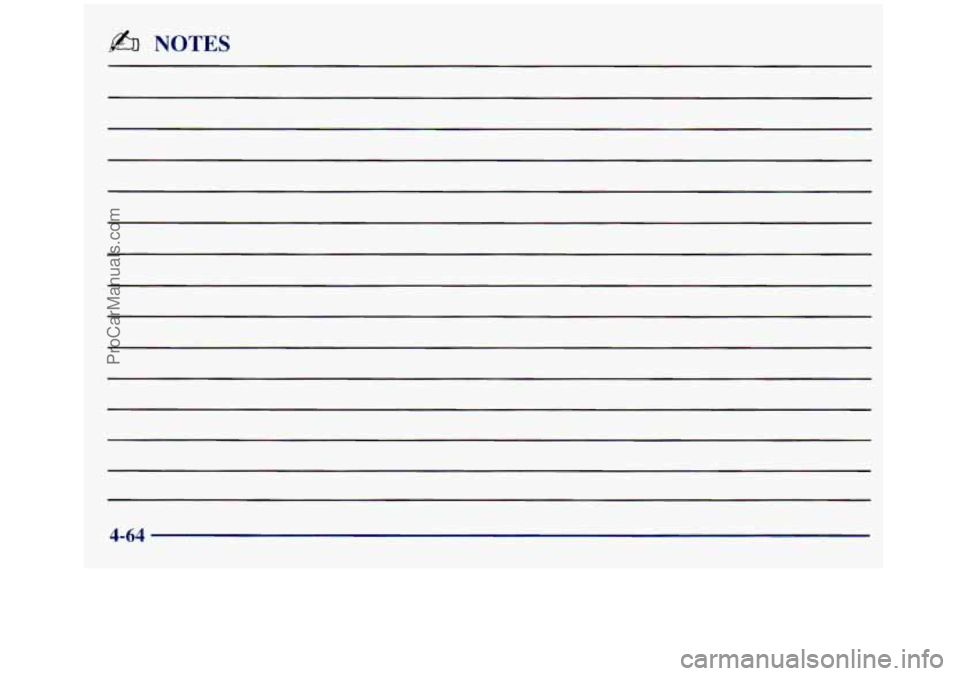
b NOTES
4-64
ProCarManuals.com
Page 253 of 452
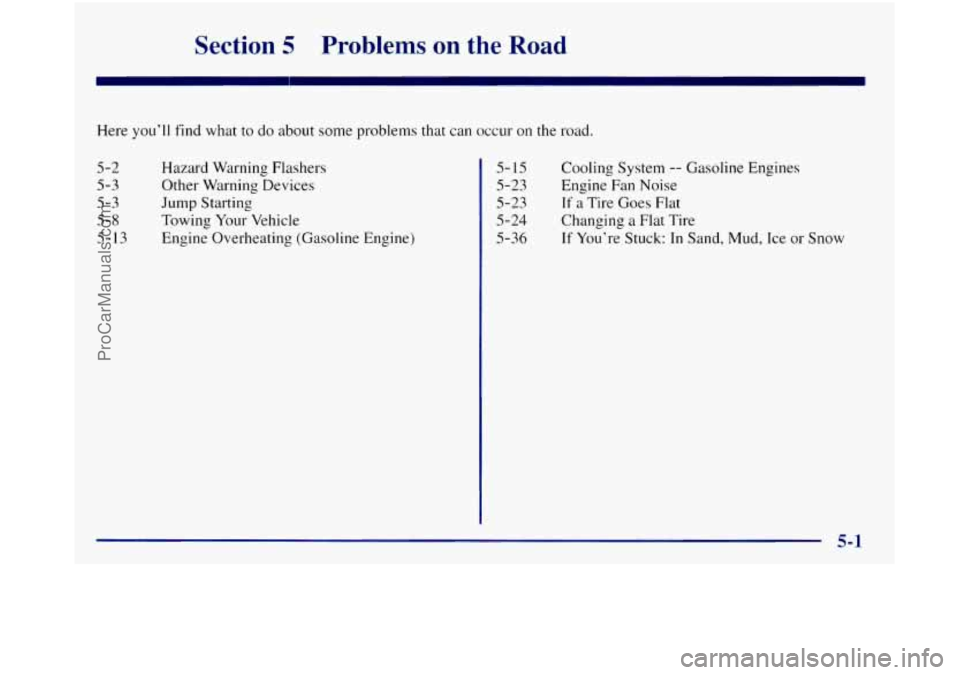
SI ;tion 5 Problems on the Road
Here you’ll find what to do about some problems that can occur on the road.
5-2
5-3
5-3
5-8
5- 13
Hazard Warning Flashers
Other Warning Devices
Jump Starting
Towing Your Vehicle
Engine Overheating (Gasoline Engine) 5- 15
5-23
5-23
5-24
5-36
Cooling System -- Gasoline Engines
Engine Fan Noise
If a Tire Goes Flat
Changing a
Flat Tire
If You’re Stuck: In Sand, Mud, Ice or Snow
5-1
ProCarManuals.com
Page 254 of 452
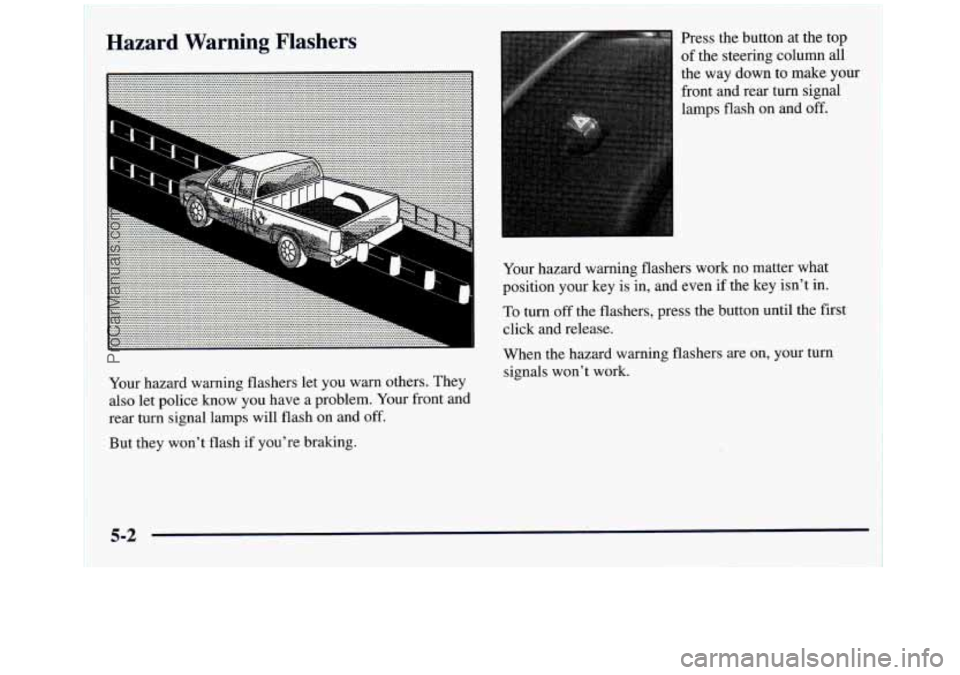
Hazard Warning Flashers
the way down to make you
front and rear turn signal
lamps flash
on and off.
-. ......................... ............................ ................................. ................................. ................................. ................................. ................................. ................................ ................................................. .................................................. .................................................. .................................................. .................................................. .................................................. ....................................................................
........................... n
................................................ ...................................................
.................................................................... ..................................................................... ........................................................................\
.... ........................................................................\
.. ........................................................................\
.... ........................................................................\
.. ........................................................................\
.... ........................................................................\
................ ........................................................................\
.................. -7a ........................................................................\
................... ........................................................................\
..................... ........................................................................\
................... ........................................................................\
..................... ........................................................................\
................... ........................................................................\
..................... ........................................................................\
................... ........................................................................\
....................................... ........................................................................\
....................................... ........................................................................\
........................................... ........................................................................\
............................................. ........................................................................\
.............................................. ........................................................................\
............................................. ........................................................................\
.............................................. 3 ........................................................................\
........................................................... ........................................................................\
............................................................ ........................................................................\
.............................................................. ........................................................................\
............................................................... ........................................................................\
.............................................................. ........................................................................\
............................................................... ........................................................................\
.............................................................. ........................................................................\
............................................................... ........................................................................\
........................................................................\
...... ........................................................................\
........................................................................\
......... ........................................................................\
........................................................................\
....... ........................................................................\
........................................................................\
...............
.................................................................... m
.::::~:..::::::....: .: ~... :.::. ..: :::::::::::.::::::::::. .:::::..::::::::::::::::::::::::::...:::::..::...::::.....::.::~
;. ........................................................................\
.................................... ..........................................
" .. ., , ..
Your hazard warning flashers let you warn others. They
also let police know you have a problem. Your front and
rear turn signal lamps will flash on and off.
But they won't flash
if you're braking.
I
Your hazard warning flashers work no matter what
position your key is in,
and even if the key isn't in.
To turn off the flashers, press the button until the fist
click
and release.
When
the hazard warning flashers are on, your turn
signals won't work.
5-2
P
ProCarManuals.com
Page 255 of 452
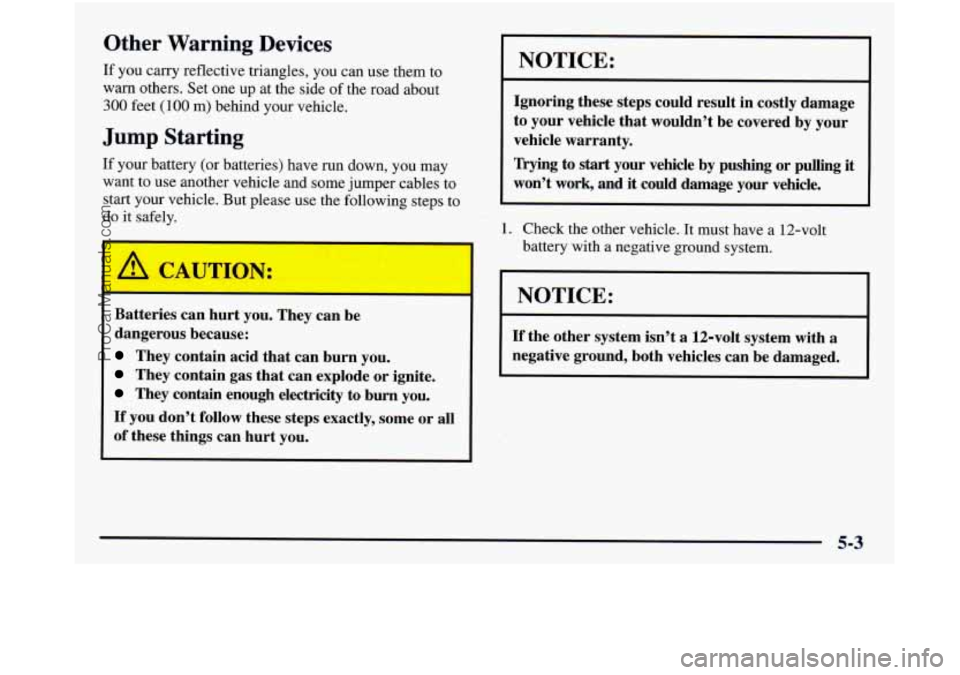
Other Warning Devices
If you carry reflective triangles, you can use them to
warn others. Set one up at the side of the road about
300 feet (100 m) behind your vehicle.
Jump Starting
I NOTICE:
Ignoring these steps could result in costly damage
to your vehicle that wouldn’t be covered by your
vehicle warranty.
If your battery (or batteries) have run down, you may nying to start your vehicle by pushing or pulling it
want to use another vehicle and some jumper cables to won’t work, and it could damage your vehicle.
start your vehicle. But please use the following steps to
do
f afely.
1. Check the other vehicle. It must have a 12-volt
Batteries can hurt you. They can be
They contain acid that can burn you.
They contain gas that can explode or ignite.
They contain enough electricity to burn you.
If you don’t follow these steps exactly, some or all
of these things can hurt you.
l dangerous because:
battery with a negative ground system.
NOTICE:
If the other system isn’t a 12-volt system with a
negative ground, both vehicles can be damaged.
I I
5-3
ProCarManuals.com
Page 256 of 452
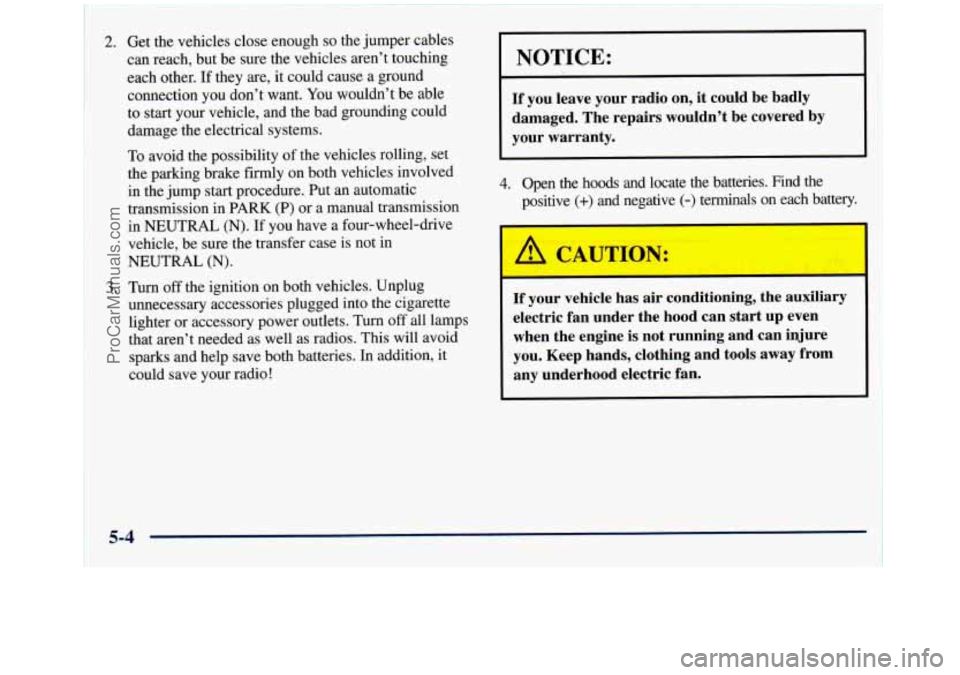
2. Get the vehicles close enough so the jumper cables
can reach, but be sure the vehicles aren’t touching
each other. If they are, it could cause a ground
connection
you don’t want. You wouldn’t be able
to start your vehicle, and the bad grounding could
damage the electrical systems.
To avoid the possibility
of the vehicles rolling, set
the parking brake firmly on both vehicles involved
in the jump start procedure. Put an automatic
transmission in
PARK (P) or a manual transmission
in NEUTRAL (N).
If you have a four-wheel-drive
vehicle, be sure the transfer case is not in
NEUTRAL
(N).
3. Turn off the ignition on both vehicles. Unplug
unnecessary accessories plugged into the cigarette
lighter or accessory power outlets. Turn
off all lamps
that aren’t needed as well as radios. This will avoid
sparks and help save both batteries. In addition, it
could save your radio!
I NOTICE:
If you leave your radio on, it could be badly
damaged. The repairs wouldn’t be covered by
your warranty.
4. Open the hoods and locate the batteries. Find the
positive
(+) and negative (-) terminals on each battery.
If your vehicle has air conditioning, the auxiliary
electric fan under the hood can start up even
when the engine is not running and can injure
you. Keep hands, clothing and tools
away from
any underhood electric fan.
5-4
t
ProCarManuals.com
Page 257 of 452
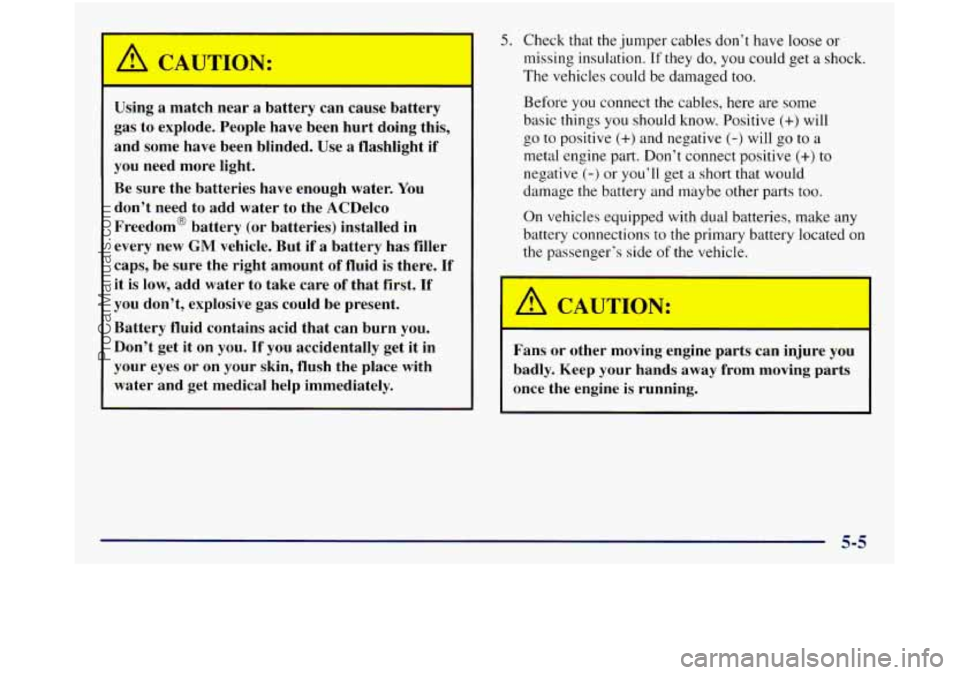
I
Using a match near a battery can cause battery
gas to explode. People have been hurt doing this,
and some have been blinded. Use a flashlight
if
you need more light.
Be sure the batteries have enough water. You
don’t need to add water to the ACDelco
Freedom@ battery (or batteries) installed in
every new
GM vehicle. But if a battery has filler
caps, be sure the right amount of fluid is there.
If
it is low, add water to take care of that first. If
you don’t, explosive gas could be present.
Battery fluid contains acid that can burn you.
Don’t get it on you.
If you accidentally get it in
your eyes or on your skin, flush the place with
water and get medical help immediately.
5. Check that the jumper cables don’t have loose or
missing insulation.
If they do, you could get a shock.
The vehicles could be damaged too.
Before you connect the cables, here are some
basic things
you should know. Positive (+) will
go to positive
(+) and negative (-) will go to a
metal engine part. Don’t connect positive
(+) to
negative
(-) or you’ll get a short that would
damage the battery and maybe other parts
too.
On vehicles equipped with dual batteries, make any
battery connections
to the primary battery located on
the passenger’s side of the vehicle.
Fans or other moving engine parts can injure you
badly. Keep your hands
away from moving parts
once the engine is running.
5-5
ProCarManuals.com
Page 258 of 452
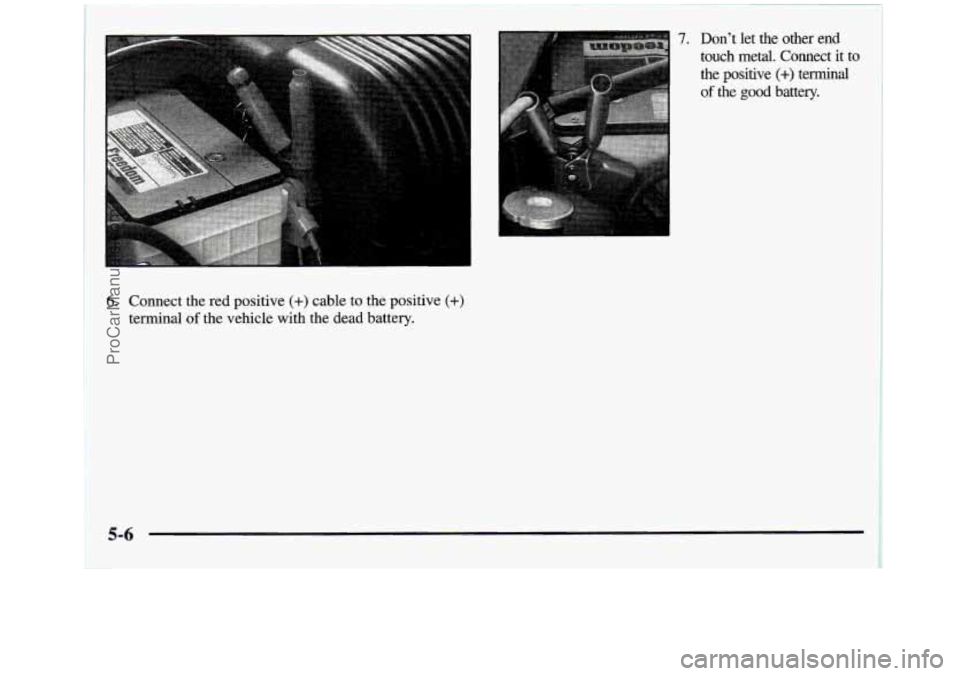
6. Connect the red positive (+) cable to the positive (+)
terminal of the vehicle with the dead battery.
7. Don’t let the other end
touch metal. Connect it to the positive
(+) terminal
of the good battery.
5-6 i
ProCarManuals.com
Page 259 of 452
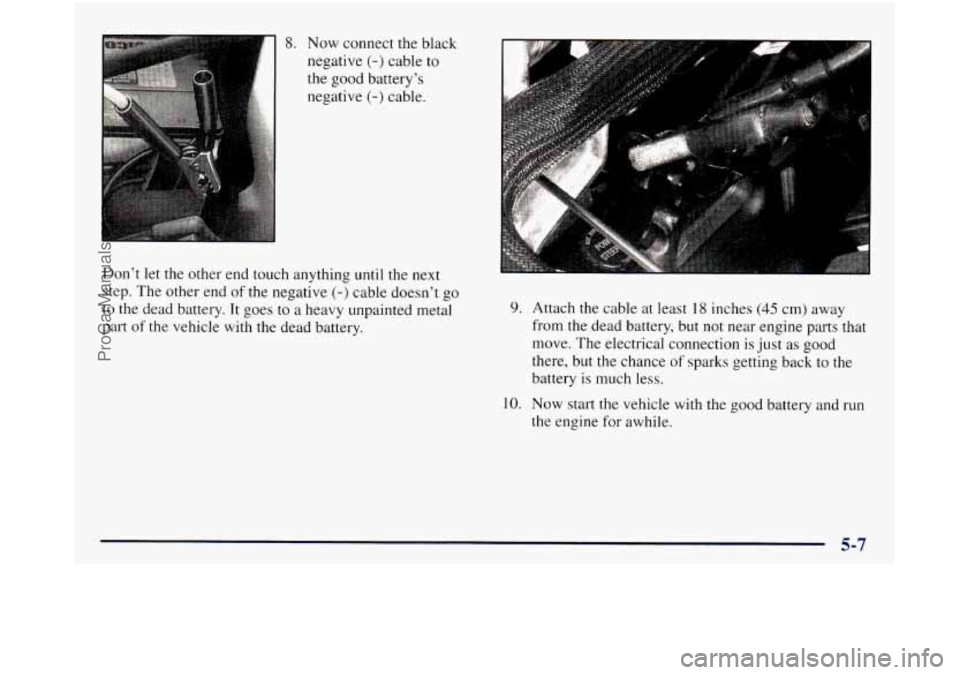
8. Now connect the black
negative
(-) cable to
the good battery’s negative
(-) cable.
Don’t
let the other end touch anything until the next
step. The other end
of the negative (-) cable doesn’t go
to the dead battery. It goes to
a heavy unpainted metal
part
of the vehicle with the dead battery.
9. Attach the cable at least 18 inches (45 cm) away
from the dead battery, but not near engine parts that
move. The electrical connection is just
as good
there, but the chance
of sparks getting back to the
battery is much less.
10. Now start the vehicle with the good battery and run
the engine
for awhile.
5-7
ProCarManuals.com
Page 260 of 452
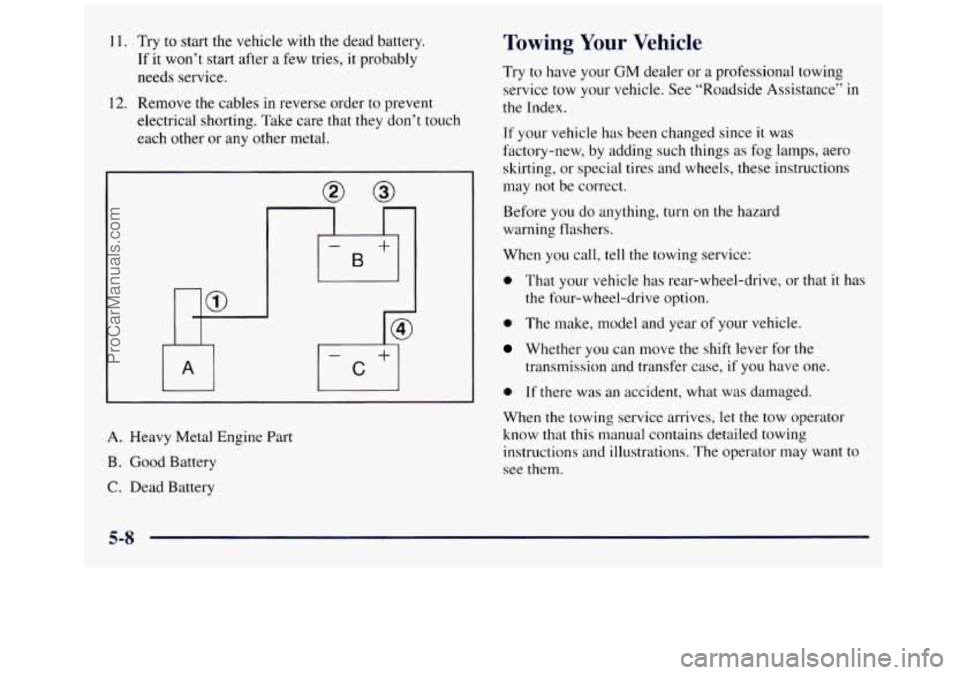
11. Try to start the vehicle with the dead battery.
If it won’t start after
a few tries, it probably
needs service.
12. Remove the cables in reverse order to prevent
electrical shorting. Take care that they don’t touch
each other or any other metal.
A. Heavy Metal Engine Part
B. Good Battery
C. Dead Battery
Towing Your Vehicle
Try to have your GM dealer or a professional towing
service tow your vehicle. See “Roadside Assistance’’
in
the Index.
If your vehicle has been changed since it was
factory-new, by adding such things
as fog lamps, aero
skirting, or special tires and wheels, these instructions
may not be correct.
Before you do anything, turn on the hazard
warning flashers.
When you call, tell the towing service:
0 That your vehicle has rear-wheel-drive, or that it has
the four-wheel-drive option.
0 The make, model and year of your vehicle.
Whether you can move the shift lever for the
0 If there was an accident, what was damaged.
When
the towing service arrives, let the tow operator
know that this manual contains detailed towing
instructions and illustrations. The operator may want to
see
them.
transmission and transfer case, if you have one.
5-8
ProCarManuals.com